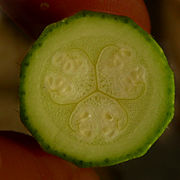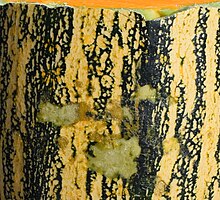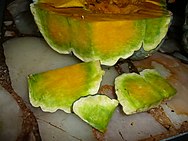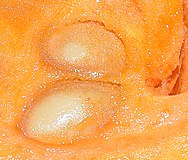Peponid
A peponid (from the Latin pepo) is a fruit whose distinctive characteristics vary according to the authors, but share the fact that it defines at least the most typical fruit of the cucurbits (at least the genera of watermelon -Citrullus-, melon -Cucumis-, and pumpkins Cucurbita).
According to LH Bailey, cited by Whitaker and Davis (1962) and in the same definition as more modern authors such as Simpson (2005, 2010), the peponid is a fruit with an inferior ovary (that is, in the distal end of the fruit should be visible the mark left by the perianth and androecium after falling, and perhaps the shriveled perianth and androecium can be seen still attached to the fruit, and the wall of the fruit, the pericarp, is formed by the ovarian tissue and the surrounding receptacle tissue); with parietal placentation, whose intrusive placentas generally almost completely occupy the interior of the ovary -the most typical in cucurbits-, although there are controversies about its interpretation. Another interpretation of placentas is that of Leins and Galle (1971), see also:261 Leins (2000:110-112) or Leins and Erbar (2010), who indicate that the septa are carpel walls, in this case the placentas would originate near the center of the ovary, whether they are fused in the center or not. In some genera the placentas have been reported to fuse in the center reverting to the plurilocular ovary and axial placentation.
There are other definitions of peponid, such as that of Schaefer and Renner in Kubitzki (ed. 2010) that define it as an armored-shell berry (Citrullus, Cucumis, Cucurbita). "In dry season habitats where most of these species are found, the armored shell fruits allow seed maturation for a longer period of time, which continues even after the rest of the vegetative shoot it has dried up". But when the shell matures, the fruit is already ripe for the perception of the guild that consumes it. The shell increases the storage time of the seeds by a few weeks to years depending on the species, which allows time for large animals to find them (Barlow 2000).
It is a syncarpic fruit (with the carpels united in a single pistil). Sometimes the false septa and pulp are resorbed and a large central cavity is formed. This is the type of fruit of pumpkins of the genus Cucurbita (squash).
The immature fruits of the cultivated species are generally large and solid, and have lost at least most of the cucurbitacins that characterize the family and that give it a bitter and toxic taste. Many cucurbits are eaten immature, cooked as a substitute for zucchini or zucchini (see zucchini) or raw as cucumbers.
Some peponides have such a hardened exocarp that they are popularly called pumpkins: those of Lagenaria, Cucurbita, Sicana. But not all pumpkins (hard-shelled berries) are peponides, that is, they come from an inferior ovary. See amphisarca (from the neo-Latin amphisarca): "In the sense of Desvaux, he defines this fruit as follows: 'plurilocular fruit, polyspermous, indehiscent, hard on the external part and fleshy internally'. Said of the fruits of the baobab (Adansonia) and the gourd or tutumo (Crescentia). They are therefore syncarpic fruits from superior ovaries, with closed carpels, a hard, woody exocarp, and the rest of the fruit is fleshy and with numerous seeds. Compare with peponid."
- Cross-section of ovary and fruit Cucurbita
Layers of pericarp
The pericarp layers were reviewed by Barber (1909) cited by Whitaker and Davis (1962), and it is divided into six distinctive tissues whose description is generalized in all cucurbits:
1. Epicarp. The cells are mostly polygonal, forming a palisade layer (palisade layer), around the stomata they are frequently elongated. The cells are cuticularized and somewhat colored on their outer wall and on their radial walls.
2. Hypodermis. Few or many isodiametric cell layers forming the tissue below the epicarp. The cells are somewhat thickened and occasionally pitted. At least in pumpkins, Lagenaria siceraria, the epidermis and hypodermis form part of the "skin" -skin- of the fruit, which in these pumpkins is the one that remains shiny after curing and after removing the waxy cuticle that covers it. Apparently, according to authors such as Simpson (2005), the epicarp and hypodermis would form the coriaceous exocarp (leather-like), the mesocarp layers are fleshy.
Endocarpio (photos 3 and 4)
3. Outer mesocarp. Isodiametric cells with cellulose or with sclerenchymatized walls and pitted ("stone cells" -stone cells-, etc.) that form a clearly defined zone that varies a few to many cells thick.
4. Middle mesocarp. Cells large and usually isodiametric, thin-walled, often turgid with a watery vacuole (watery cell sap) and contain a small amount of starch. To this layer would belong the white part of the "shell" of the watermelon, and the green layer that surrounds the orange pulp of some pumpkins (Cucurbita).
5. Internal mesocarp. Many thin-walled cell layers closely resembling the middle mesocarp. For example, it is the layer that forms the central mass of pink, white or yellowish tissue in Citrullus (watermelon) (:294), in Cucurbita the cells are large (:275) and this layer also occupies the center of the fruit, where in Cucurbita there is a mass of resistant fibers surrounded by the remains of the disintegrated parenchyma which has formed a cavity.
6. Endocarp. Very small, thin-walled, tangentially elongated cells, arranged side by side in distinct groups, forming a thin, transparent tissue. In some varieties, this layer remains so firmly attached to the dry seed that some authors describe it as the outermost layer of the seed coat. Teppner (2004) calls it "placenta-epidermis" (placenta epidermis) and indicates that it may not be present (:265). He reports that in some cases it functionally replaces the aborted epidermis, then adheres more strongly to the rest of the testa as part of the "seed coat"; (seed mantle) but "it can never be as integral a part of the mantle as normal epidermis and is therefore more or less mechanically removable" (:285-286).
Immature fruits
The immature fruits of cucurbits are characteristic and many of them are popularly recognized as such (with names such as gourds), the immature stage is much more conserved than the mature fruit, which can be much more variable. Fruits such as those of Luffa (the genus of vegetable sponge) and Momordica (a genus that dehisces when ripe and exposes the arlated seeds for dispersal) are recognizable as gourds. But few definitions of peponid include them.
Quotes
- ↑ a bc Kubitzki (2010): "Berries are the most common fruit type (in Cucurbitaceae), and they can be hard-shelled, then called gourd or pepo (Citrullus, Cucumis, Cucurbita)..." "In the seasonally dry habitats, where most of these species occur, hard-shelled water-storing fruits allow for prolongued protected seed maturation, which continues even after the remainder of the vegetative shoot has mostly dried out and died off."
- ↑ The pioneer paper on neotropical genres Crescentia, Gleditsia, Enterolobium, Maclura, Diospyros, Carica, Persea, Asimina, Prosopis and Cucurbita is: Janzen, D and P Martin. 1982. Neotropical anachronisms. The fruits that gomphoteres ate. Science 255:19-27. A later book based on that paper is Connie Barlow. 2000. The Ghosts of Evolution. Nonsensical fruit, missing partners and other ecological anachronisms. First edition. Basic Books. A member of the Perseus Book Group. Available online at: http://thegreatstory.org/CB-writings.html
Contenido relacionado
Nucleoid
Chromosome mutation
Dinophyceae









